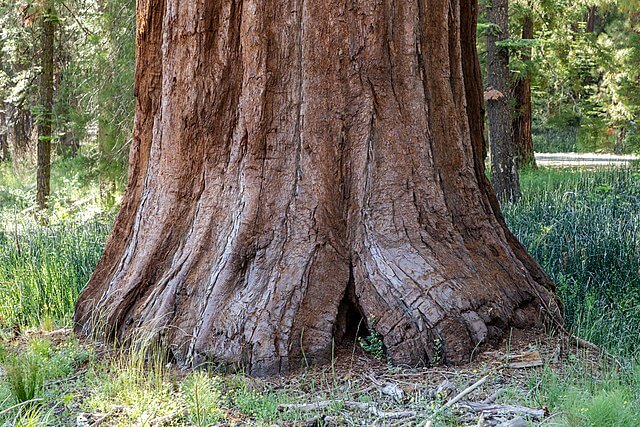
The world’s largest trees, giant redwoods, are flourishing in the UK, according to a recent study.
Initially introduced to the UK approximately 160 years ago, these majestic trees are displaying growth rates comparable to their counterparts in their native habitat of California’s Sierra Nevada mountains.
Despite not yet reaching the towering heights seen in their Californian brethren, with the tallest UK specimen measuring at 54.87 meters compared to the 90 meters achieved in California, researchers are optimistic about their future prospects. Given their potential lifespan of over 2,000 years, the UK’s redwoods have ample time to catch up in stature.
Estimates suggest that there are around half a million redwoods in the UK, encompassing various species such as the giant redwoods (Sequoiadendron giganteum), coastal redwoods, and dawn redwoods. However, it is believed that the majority are giant redwoods.
In contrast, their native range in California hosts approximately 80,000 mature giant redwoods.
“Half a million trees is quite a lot to go under the radar until now, but it’s when you start looking for them in the landscape, and compiling these datasets, that you realise how many there are,” said Dr Phil Wilkes, one of the authors of the study, from Kew’s botanic garden at Wakehurst in Sussex.
The Victorians initially introduced giant redwoods to the UK, often as a symbol of botanical prestige, adorning the expansive estates of the wealthy. Today, these towering giants can be found gracing sweeping avenues or standing solitary in parks, easily recognisable by their imposing stature and dense, cone-shaped crowns.
To assess their adaptation to the UK environment, researchers selected nearly 5,000 trees for study across various locations, employing laser scanning techniques to measure their heights and volumes non-invasively. The results revealed that the UK’s giant redwoods are thriving, with growth rates comparable to those in their native habitat.
Dr. Wilkes noted that the UK climate seems to suit them well.
“Where they grow in California, it’s cooler and moister than you would typically envisage California to be,” he explained.
“And we have a reasonably similar climate here – it’s very wet and they need the moisture to grow.”
Furthermore, the study examined the carbon sequestration capacity of these trees, highlighting their role in mitigating climate change by absorbing and storing carbon dioxide. While UK redwoods may not sequester as much carbon dioxide as their counterparts in the US, their sheer size allows them to lock up significant amounts of the greenhouse gas.
The trees at Wakehurst, reaching approximately 45 meters in height, store an estimated 10 to 15 tonnes of carbon, Dr Wilkes explained.
“But compare this to the largest tree in California, which has about 250 tonnes of carbon stored in it, and they’re quite small. But you know, these could get as big.”
However, researchers caution against relying solely on giant redwoods to combat climate change. While they can contribute to carbon sequestration in mixed forest plantations alongside other tree species, widespread planting of redwoods alone is insufficient to address rising atmospheric carbon dioxide levels.
With California’s native redwoods facing threats from climate change-induced factors like hotter, drier weather and wildfires, could the UK serve as a new habitat for these iconic trees? Prof. Mat Disney from University College London believes it’s plausible, particularly considering the changing climate conditions.
“In terms of climate, it’s probably the case that they’re going to have a less pressured existence here than they do in California,” he said.
Local authorities across the UK are already planting redwood saplings in public parks and recreation areas, anticipating their enduring presence.
Prof Disney says they have a long life ahead of them – and they won’t stay small for long.
“They’re very fast growing, and they grow large. Once they reach about 60m, they will be the tallest trees in Britain, and then they will keep on growing,” he said.
Despite their success in the UK, the likelihood of giant redwoods displacing native forests remains low, primarily due to their specific reproductive requirements. Unlike some other tree species, they necessitate precise conditions for successful seed germination and growth.
The findings of this study were published in the Royal Society journal Open Science.
——————————————————————————
At Natural World Fund, we are passionate about stopping the decline in our wildlife.
The decline in our wildlife is shocking and frightening. Without much more support, many of the animals we know and love will continue in their decline towards extinction.
When you help to restore a patch of degraded land through rewilding to forests, meadows, or wetlands, you have a massive impact on the biodiversity at a local level. You give animals a home and food that they otherwise would not have had, and it has a positive snowball effect on the food chain.
We are convinced that this is much better for the UK than growing lots of fast-growing coniferous trees, solely to remove carbon, that don’t actually help our animals to thrive.
This is why we stand for restoring nature in the UK through responsible rewilding. For us, it is the right thing to do. Let’s do what’s right for nature!
Donate today at https://naturalworldfund.com/ and join in the solution!

